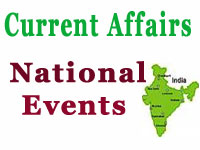Current Affairs Study Material (Part 2) on National News – July 2015
Union Government Sanctioned 30 Cold Chain Projects
- The Union government sanctioned proposals on May 18, 2015 for setting-up the remaining 30 new cold chains in the country with a total investment of ? 724.9 crore out of the 138 integrated cold chain projects that were approved by the government.
- The Food Processing Ministry provides financial assistance of up to ? 10 crore and will also provide grant of ? 274.9 crore on these projects. These projects will help in a big way in reducing the wastage of food.
- The total capacity of these projects will be 1.12 lakh tonnes of cold storage and 11.10 lakh litres of milk per day. It would attract an investment of another ? 470 crore. It will also result in addition of 209 reefer or refrigerated container vehicles.
- Once all these 138 cold chain projects become operational, it will add 4.76 lakh tonnes of storage capacity and 118 lakh litres per day milk processing capacity and 810 reefer vehicles.
IMD and POSOCO Signed an MoU to Increase the Efficiency of Power Sector
- Earth System Science Organisation-India Meteorological Department (ESSO-IMD), Ministry of Earth Sciences and Power System Operation Corporation (POSOC0), a wholly owned subsidiary of Power Grid Corporation of India (PGCIL), signed a Memorandum of Understandings (MoU) on May 18, 2015 for optimum use of weather information or forecast in the power sector.
Salient Features of the MoU
- Power System Operators across India shall used all weather information provided by ESSO-IMD for better management of Indian Power System and for the purpose of analysis.
- ESSO-IMD shall make available current weather information for the identified stations; and forecasts at different time scales of temperature, humi.dity, wind speed, wind direction, rainfall and other meteorological parameters of the identified stations/sectors.
- ESSO-IMD must provide weather warnings about likely occurrences of thunderstorm, heat wave, cold wave, rainfall, fog etc. over various states up to next 72 hours. It will also provide State/Regidn wise Monthly/Seasonal outlooks of weather conditions.
Also Get: Sample Paper for Govt. Exams
Sixth National Conference on Nuclear Energy Held
- One of the apex trade associations of India, Associated Chambers of Commerce and Industry of India (ASSOCHAM), organised Sixth edition of National Conference on Nuclear Energy at New Delhi on May 16, 2015.
- The theme of this edition was Nuclear Energy: A Clean Energy Option. The issues related to the status of Nuclear Energy in India were discussed in the conference. India is on the way of doubling its nuclear power generation capacity in next five years i.e., till 2020 by more than 10000 MW.
- Apart nuclear energy to the de-carbonisation of power sector, climate change & the future of nuclear energy, nuclear energy expansion, and Make in India issues are also discussed.
Union Cabinet Approved 120000 Crore for ‘Namami Gange’ Programme
- The Union Cabinet, chaired by Narendra Modi, approved a massive ? 20000 crore budget for ‘Namami Gange’ programme for the next five years.
- It is a five-fold increase over the money spent in the last 30 years towards the . conservation of the river. The Centre will take over 100% funding of various activities/projects under this programme.
- The programme also focuses on involving .the States and grassroots-level institutions such as Urban Local Bodies and Panchayati Raj Institutions for its implementation.
- The programme would be implemented by the National Mission for Clean Ganga (NMCG), and its State counterpart organisations, i.e. the State Programme Management Groups (SPMGs).
Road Measurement and Data Acquisition System Launched
- Union Road Transport and Highways Minister Nitin Gadkari launched a new programme Road Measurement and Data Acquisition System on May 15, 2015 to take stock of th.e condition of the National Highways (NH) including their maintenance.
- A vehicle equipped with modern gadgets including GPS, advanced lasers, cameras will cover every aspect of the road including road condition, wayside amenities, accident-prone zones, road strength, condition of bridges and culverts besides encroachment.
- The project is funded by the World Bank and National Highway Authority of India (NHAI). The first phase of data collection commenced from Nagpur on May 5, 2015.
- It will cover 3000 km of national highways spreading across Maharashtra, Madhya Pradesh, Uttar Pradesh, Pubjab, Gujarat and Rajasthan and it will be completed by September, 2015.
Centre Launched National Emergency Response System to Save Women in Distress
- The Centre invited offers from IT service providers to implement the National Emergency Response System (NERS) project on May 15, 2015 in order to make the police immediately respond to any call by a woman in distress anywhere in India.
- The NERS is designed to have at least one Phblic Safety Answering Point (PSAP) in each State. It is quite close to the 911 number system of the USA. The PSAP is a call centre where all calls originating in that State will land and will be answered.
- The idea of NERS was envisaged during Congress led United Progressive Alliance (UPA) government’s regime as a response to Delhi gang rape case of December, 2012 but was yet to be implemented.
USTAD Scheme Launched in Varanasi
- Union Minister Najfna Heptullah launched a welfare scheme, Upgradation of Skills and Training in Ancestral arts/crafts for Development (USTAD), aimed at upgrading and promoting the skills of artisans from the minority community, on May 14, 2015. It is launched from Varanasi in order to improve degrading conditions of world famous Banaras Saree weavers who belong to minority communities.
- The programme is linked to the ‘Make in India’ campaign and termed as close to the Prime Minister’s heart. It seeks to help weavers and artisans connect with buyers all over the world.
- A portal dedicated to the programme was also launched to help artisans to log in and get connected to potential buyers world-over. The National Institute of Design along with a host of other bodies would be associated with this mission and improve designs of the produce.
- The Upgradation of Skills and Training in Ancestral Arts/Crafts for Development (USTAD) scheme was announced in 2014 with the Finance Ministry allocating 17 crore for the scheme.
Union Cabinet gave Nod to Benami Transaction Prohibition Bill
- The Union Cabinet approved the new Benami Transaction Prohibition (Amendment) Bill, 2015 on May 13, 2015. The Bill seeks to amend the Benami Transactions (Prohibition) Act, 1988. The Budget for 2015-16 had proposed a comprehensive bill on the benami transactions.
- The Bill provides for attachment and confiscation of benami properties and also fine with imprisonment. So, it will fight with the menace of unaccounted wealth or black money inside the country, especially in Real Estate.
- Benami implies buying immovable and other properties in others’ names to avoid tax and disclosure of ownership. The practice has been prevalent in India for decades and is considered one of the major causes of generation of black money.
Lok Sabha Passed Negotiable Instruments (Amendment) Bill
- The Lok Sabha passed the Negotiable Instruments (Amendment) Bill, 2015 by voice vote on May 13, 2015. The Bill amended the Negotiable Instruments Act, 1881 in order to make filing of cases regarding cheque-bounce more convenient for check payees.
- The Bill was necessitated due to an earlier ‘impractical’ Supreme Court order that cases against those, having defaulted on their cheque payments could only be filed in courts under which jurisdiction the bank account of the accused fell.
- Keeping in view the interest of complainants and to address the difficulties faced’by the lender of the money in filing the case under Section-138 of the Act, the jurisdiction for offence has been clearly defined in the new Bill.
- The Courts were currently dealing with 21 lakh cheque-bounce cases with 259 Courts hearing them exclusively and the new law would help consolidate the cases and aid the judicial system.
Cabinet Approved Changes in Child Labour Law
The Union Cabinet gave its nod to the Child Labour (Prohibition and Regulation) Amendment Bill, 2012 on May 13, 2015. The proposal allowed children below 14 years of age to work only in family enterprises or entertainment industry with certain conditions while completely banning their employment elsewhere.
- The original child labour law banned employment of children below 14 in only 18 hazardous industries. The amendments also make it clear that children between 14 and 18 years will also not be allowed to work in hazardous industries.
- The changes in the labour law also provide for stricter punishment for employers for violation. While, there is no penalty provision for parents for the first offence, the employer would be liable for punishment even for the first violation.
- In case of parents, the repeat offenders may be penalised with a monetary fine up to 10000 and of first offence, the penalty for employers has been increased up to two and half times from the existing up to 20000 to up to 50000 now.
Also Read: Sports Current Affairs October 2015
Rajya Sabha Approved Changes in Companies Act to Improve Biz Climate
- The Rajya Sabha passed Companies (Amendment) Bill, 2014 with an aim of promoting ease of doing business on May 13, 2015 by voice vote. The amendments were needed as there have been complaints from the corporates about the problems ever since the law was enacted in 2013.
- There were 16 amendments made to the Companies Act of 2013 which mainly deal with winding up of companies, board resolutions, bail provisions and utilisation of unclaimed dividends to bring the law in tune with the global standards.
- The amendments were aimed at simplifying bail provisions. Now, “except in various issues of serious frauds, normal CrPC provisions” would apply. The law will be reviewed further by an expert committee to be set-up shortly.
Supreme Court Issued Guidelines on Government Advertisements
- The Supreme Court issued a slew of guidelines on regulation of public advertisements on May 13, 2015. The Supreme Court directed that the advertisements can carry pictures of certain dignitaries like the President, Prime Minister and the Chief Justice of India.
- The Apex Court on April 24, 2015 had set-up a three-member committee and decided to frame guidelines to prevent ‘misuse’ of public funds by the government and authorities in giving ads in newspapers and television to gain political mileage.
- In order to regulate the issue of public advertisement and to keep check on framed guidelines to prevent its violation the Supreme Court also asked the Central government to constitute a three-member committee.
- National Current Affairs of July Month Part 3
Click Here to Register For Private Jobs, Current Affairs Alert directly in Your Inbox.
Visit Current-affairs.org for Latest Private Jobs and Current Affair and previous year question papers Updates.




